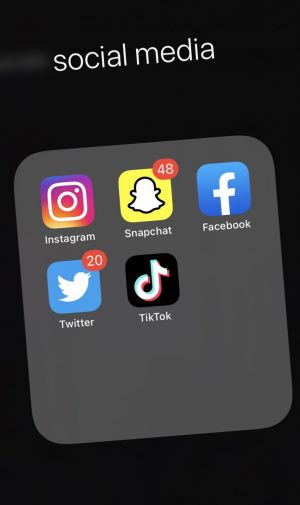Social Media’s Grip on Society
May 12, 2023
The future will have flying cars!
Robots are going to take over the world!
Computers will soon be smarter than us!
For decades, the world has fantasized about a technology-driven future. As a society, we spent decades drooling over the idea of jetpacks propelling us from Point A to Point B; we dreamed about a world in which we lived amongst robots. What many people fail to realize, however, is that this fantasy is upon us. The technology-driven world we once visualized is upon us, but it looks different than how we pictured it.
Gen Z’s obsession with social media and participation in cancel culture has proven to be harmful; the dependence on social media and modern-day technology must be terminated. Cell phones and modern-day social media have only been in existence for the last twenty or so years. Within the blink of an eye, we switched from handwritten letters to ILY, from hugs to heart emojis, and from happy, heartfelt memories to ‘BeReal’.
Youths everywhere are spending more and more time bent over phone screens. Teenagers at social gatherings worldwide cannot be seen without phones in their hands or back pockets. All moments on Instagram are posed and forced, but no moment is left undocumented.
“The overuse of social media can actually rewire a young child or teen’s brain to constantly seek out immediate gratification, leading to obsessive, compulsive and addictive behaviors,” says Nancy DeAngelis, director of Behavioral Health at Jefferson Health in Abington. “This is what can make mental health disorders such as anxiety, depression, ADHD and body dysmorphia worse.”
Platforms such as TikTok, Instagram, and Twitter frequently feature different posts detailing the newest fad diets and trendy weight loss ads. Comments are littered with highly-liked quips poking fun at peoples’ bodies and making fun of superficial things. Celebrities and everyday people are “canceled” before their careers can even begin.
Not only can social media inspire individual harmful mental effects, but it can also encourage cyberbullying and anonymous teasing. “Of all the social networks, kids on YouTube are the most likely to be cyberbullied at 79 percent, followed by Snapchat at 69 percent, TikTok at 64 percent, and Facebook at 49 percent” (“Cyberbullying: Twenty Crucial Statistics for 2023”).
To make a positive change in the mental health epidemic sweeping our nation, the obsession and dependence on social media must stop. Our society cannot function in such a way and will soon face the inevitable consequences. Our youth cannot be raised in such a way. It’s time to make a change. Parents must reconsider their opinions on granting their young children access to such a toxic social climate through the lens of social media. Young adults must prioritize more old-fashioned methods of communication before social skills disappear entirely.
“Cyberbullying: Twenty Crucial Statistics for 2023.” Security.org, 26 Jan. 2023, https://www.security.org/resources/cyberbullying-facts-statistics/#resources.
Miller, Sarah. “The Addictiveness of Social Media: How Teens Get Hooked.” Jefferson Health – Greater Philadelphia & South Jersey Region, Jefferson Health, 2 June 2022, https://www.jeffersonhealth.org/your-health/living-well/the-addictiveness-of-social-media-how-teens-get-hooked#:~:text=%E2%80%9CThe%20overuse%20of%20social%20media,ADHD%20and%20body%20dysmorphia%20worse.%E2%80%9D






